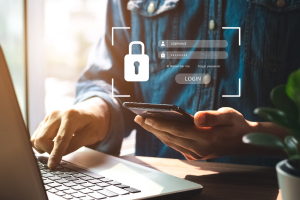
Chances are, you have more personal information posted online than you think.
In 2024, the U.S. Federal Trade Commission (FTC) reported that 1.1 million identity theft complaints were filed, where $12.5 billion was lost to identity theft and fraud overall—a 25% increase over the year prior.
What fuels all this theft and fraud? Easy access to personal information.
Here’s one way you can reduce your chances of identity theft: remove your personal information from the internet.
Scammers and thieves can get a hold of your personal information in several ways, such as information leaked in data breaches, phishing attacks that lure you into handing it over, malware that steals it from your devices, or by purchasing your information on dark web marketplaces, just to name a few.
However, scammers and thieves have other resources and connections to help them commit theft and fraud—data broker sites, places where personal information is posted online for practically anyone to see. This makes removing your info from these sites so important, from both an identity and privacy standpoint.
Data broker sites are massive repositories of personal information that also buy information from other data brokers. As a result, some data brokers have thousands of pieces of data on billions of individuals worldwide.
What kind of data could they have on you? A broker may know how much you paid for your home, your education level, where you’ve lived over the years, who you’ve lived with, your driving record, and possibly your political leanings. A broker could even know your favorite flavor of ice cream and your preferred over-the-counter allergy medicine thanks to information from loyalty cards. They may also have health-related information from fitness apps. The amount of personal information can run that broadly, and that deeply.
With information at this level of detail, it’s no wonder that data brokers rake in an estimated $200 billion worldwide every year.
Your personal information reaches the internet through six main methods, most of which are initiated by activities you perform every day. Understanding these channels can help you make more informed choices about your digital footprint.
When you buy a home, register to vote, get married, or start a business, government agencies create public records that contain your personal details. These records, once stored in filing cabinets, are now digitized, accessible online, and searchable by anyone with an internet connection.
Every photo you post, location you tag, and profile detail you share contributes to your digital presence. Even with privacy settings enabled, social media platforms collect extensive data about your behavior, relationships, and preferences. You may not realize it, but every time you share details with your network, you are training algorithms that analyze and categorize your information.
You create accounts with retailers, healthcare providers, employers, and service companies, trusting them to protect your information. However, when hackers breach these systems, your personal information often ends up for sale on dark web marketplaces, where data brokers can purchase it. The Identity Theft Research Center Annual Data Breach Report revealed that 2024 saw the second-highest number of data compromises in the U.S. since the organization began recording incidents in 2005.
When you browse, shop, or use apps, your online behavior is recorded by tracking pixels, cookies, and software development kits. The data collected—such as your location, device usage, and interests—is packaged and sold to data brokers who combine it with other sources to build a profile of you.
Grocery store cards, coffee shop apps, and airline miles programs offer discounts in exchange for detailed purchasing information. Every transaction gets recorded, analyzed, and often shared with third-party data brokers, who then create detailed lifestyle profiles that are sold to marketing companies.
Data brokers act as the hubs that collect information from the various sources to create comprehensive profiles that may include over 5,000 data points per person. Seemingly separate pieces of information become a detailed digital dossier that reveals intimate details about your life, relationships, health, and financial situation.
Legally, your aggregated information from data brokers is used by advertisers to create targeted ad campaigns. In addition, law enforcement, journalists, and employers may use data brokers because the time-consuming pre-work of assembling your data has largely been done.
Currently, the U.S. has no federal laws that regulate data brokers or require them to remove personal information if requested. Only a few states, such as Nevada, Vermont, and California, have legislation that protects consumers. In the European Union, the General Data Protection Regulation (GDPR) has stricter rules about what information can be collected and what can be done with it.
On the darker side, scammers and thieves use personal information for identity theft and fraud. With enough information, they can create a high-fidelity profile of their victims to open new accounts in their name. For this reason, cleaning up your personal information online makes a great deal of sense.
Understanding which data types pose the greatest threat can help you prioritize your removal efforts. Here are the high-risk personal details you should target first, ranked by their potential for harm.
When prioritizing your personal information removal efforts, focus on combinations of data rather than individual pieces. For example, your name alone poses minimal risk, but your name combined with your address, phone number, and date of birth creates a comprehensive profile that criminals can exploit. Tools such as McAfee Personal Data Cleanup can help you identify and remove these high-risk combinations from data broker sites systematically.
This process takes time and persistence, but services such as McAfee Personal Data Cleanup can continuously monitor for new exposures and manage opt-out requests on your behalf. The key is to first understand the full scope of your online presence before beginning the removal process.
Let’s review some ways you can remove your personal information from data brokers and other sources on the internet.
Once you have found the sites that have your information, the next step is to request to have it removed. You can do this yourself or employ services such as McAfee’s Personal Data Cleanup, which can help manage the removal for you depending on your subscription. It also monitors those sites, so if your info gets posted again, you can request its removal again.
You can request to remove your name from Google search to limit your information from turning up in searches. You can also turn on “Auto Delete” in your privacy settings to ensure your data is deleted regularly. Occasionally deleting your cookies or browsing in incognito mode prevents websites from tracking you. If Google denies your initial request, you can appeal using the same tool, providing more context, documentation, or legal grounds for removal. Google’s troubleshooter tool may explain why your request was denied—either legitimate public interest or newsworthiness—and how to improve your appeal.
It’s important to know that the original content remains on the source website. You’ll still need to contact website owners directly to have your actual content removed. Additionally, the information may still appear in other search engines.
If you have old, inactive accounts that have gone by the wayside such as Myspace or Tumblr, you may want to deactivate or delete them entirely. For social media platforms that you use regularly, such as Facebook and Instagram, consider adjusting your privacy settings to keep your personal information to the bare minimum.
If you’ve ever published articles, written blogs, or created any content online, it is a good time to consider taking them down if they no longer serve a purpose. If you were mentioned or tagged by other people, it is worth requesting them to take down posts with sensitive information.
Another way to tidy up your digital footprint is to delete phone apps you no longer use as hackers are able to track personal information on these and sell it. As a rule, share as little information with apps as possible using your phone’s settings.
After sending your removal request, give the search engine or source website 7 to 10 business days to respond initially, then follow up weekly if needed. If a website owner doesn’t respond within 30 days or refuses your request, you have several escalation options:
For comprehensive guidance on website takedown procedures and your legal rights, visit the FTC’s privacy and security guidance for the most current information on consumer data protection. Direct website contact can be time-consuming, but it’s often effective for removing information from smaller sites that don’t appear on major data broker opt-out lists. Stay persistent, document everything, and remember that you have legal rights to protect your privacy online.
After you’ve cleaned up your data from websites and social platforms, your web browsers may still save personal information such as your browsing history, cookies, autofill data, saved passwords, and even payment methods. Clearing this information and adjusting your privacy settings helps prevent tracking, reduces targeted ads, and limits how much personal data websites can collect about you.
When your home address is publicly available, it can expose you to risks like identity theft, stalking, or targeted scams. Taking steps to remove or mask your address across data broker sites, public records, and even old social media profiles helps protect your privacy, reduce unwanted contact, and keep your personal life more secure.
The cost to remove your personal information from the internet varies, depending on whether you do it yourself or use a professional service. Read the guide below to help you make an informed decision:
Removing your information on your own primarily requires time investment. Expect to spend 20 to 40 hours looking for your information online and submitting removal requests. In terms of financial costs, most data brokers may not charge for opting out, but other expenses could include certified mail fees for formal removal requests—about $3-$8 per letter—and possibly notarization fees for legal documents. In total, this effort can be substantial when dealing with dozens of sites.
Depending on which paid removal and monitoring service you employ, basic plans typically range from $8 to $25 monthly while annual plans, which often provide better value, range from $100 to $600. Premium services that monitor hundreds of data broker sites and provide ongoing removal can cost $1,200-$2,400 annually.
The difference in pricing is driven by several factors. This includes the number of data broker sites to be monitored, which could cover more than 200 sites, and the scope of removal requests which may include basic personal information or comprehensive family protection. The monitoring frequency and additional features such as dark web monitoring, credit protection, and identity restoration support and insurance coverage typically command higher prices.
The upfront cost may seem significant, but continuous monitoring provides essential value. A McAfee survey revealed that 95% of consumers’ personal information ends up on data broker sites without their consent. It is possible that after the successful removal of your information, it may reappear on data broker sites without ongoing monitoring. This makes continuous protection far more cost-effective than repeated one-time cleanups.
Services such as McAfee Personal Data Cleanup can prove invaluable, as it handles the initial removal process, as well as ongoing monitoring to catch when your information resurfaces, saving you time and effort while offering long-term privacy protection.
Aside from the services above, comprehensive protection software can help safeguard your privacy and minimize your exposure to cybercrime with these offerings such as:
So while it may seem like all this rampant collecting and selling of personal information is out of your hands, there’s plenty you can do to take control. With the steps outlined above and strong online protection software at your back, you can keep your personal information more private and secure.
Unlike legitimate data broker sites, the dark web operates outside legal boundaries where takedown requests don’t apply. Rather than trying to remove information that’s already circulating, you can take immediate steps to reduce the potential harm and focus on preventing future exposure. A more effective approach is to treat data breaches as ongoing security issues rather than one-time events.
Both the FTC and Cybersecurity and Infrastructure Security Agency have released guidelines on proactive controls and continuous monitoring. Here are key steps of those recommendations:
As you go about removing your information for the internet, it is important to set realistic expectations. Several factors may limit how completely you can remove personal data from internet sources:
While some states like California have stronger consumer privacy rights, most data removal still depends on voluntary compliance from companies.
Removing your personal information from the internet takes effort, but it’s one of the most effective ways to protect yourself from identity theft and privacy violations. The steps outlined above provide you with a clear roadmap to systematically reduce your online exposure, from opting out of data brokers to tightening your social media privacy settings.
This isn’t a one-time task but an ongoing process that requires regular attention, as new data appears online constantly. Rather than attempting to complete digital erasure, focus on reducing your exposure to the most harmful uses of your personal information. Services like McAfee Personal Data Cleanup can help automate the most time-consuming parts of this process, monitoring high-risk data broker sites and managing removal requests for you.
The post How to Remove Your Personal Information From the Internet appeared first on McAfee Blog.

Data Privacy Week is here, and there’s no better time to shine a spotlight on one of the biggest players in the personal information economy: data brokers. These entities collect, buy, and sell hundreds—sometimes thousands—of data points on individuals like you. But how do they manage to gather so much information, and for what purpose? From your browsing habits and purchase history to your location data and even more intimate details, these digital middlemen piece together surprisingly comprehensive profiles. The real question is: where are they getting it all, and why is your personal data so valuable to them? Let’s unravel the mystery behind the data broker industry.
Data brokers aggregate user info from various sources on the internet. They collect, collate, package, and sometimes even analyze this data to create a holistic and coherent version of you online. This data then gets put up for sale to nearly anyone who’ll buy it. That can include marketers, private investigators, tech companies, and sometimes law enforcement as well. They’ll also sell to spammers and scammers. (Those bad actors need to get your contact info from somewhere — data brokers are one way to get that and more.)
And that list of potential buyers goes on, which includes but isn’t limited to:
These companies and social media platforms use your data to better understand target demographics and the content with which they interact. While the practice isn’t unethical in and of itself (personalizing user experiences and creating more convenient UIs are usually cited as the primary reasons for it), it does make your data vulnerable to malicious attacks targeted toward big-tech servers.
Most of your online activities are related. Devices like your phone, laptop, tablets, and even fitness watches are linked to each other. Moreover, you might use one email ID for various accounts and subscriptions. This online interconnectedness makes it easier for data brokers to create a cohesive user profile.
Mobile phone apps are the most common way for data brokerage firms to collect your data. You might have countless apps for various purposes, such as financial transactions, health and fitness, or social media.
A number of these apps usually fall under the umbrella of the same or subsidiary family of apps, all of which work toward collecting and supplying data to big tech platforms. Programs like Google’s AdSense make it easier for developers to monetize their apps in exchange for the user information they collect.
Data brokers also collect data points like your home address, full name, phone number, and date of birth. They have automated scraping tools to quickly collect relevant information from public records (think sales of real estate, marriages, divorces, voter registration, and so on).
Lastly, data brokers can gather data from other third parties that track your cookies or even place trackers or cookies on your browsers. Cookies are small data files that track your online activities when visiting different websites. They track your IP address and browsing history, which third parties can exploit. Cookies are also the reason you see personalized ads and products.
Data brokers collate your private information into one package and sell it to “people search” websites. As mentioned above, practically anyone can access these websites and purchase extensive consumer data, for groups of people and individuals alike.
Next, marketing and sales firms are some of data brokers’ biggest clients. These companies purchase massive data sets from data brokers to research your data profile. They have advanced algorithms to segregate users into various consumer groups and target you specifically. Their predictive algorithms can suggest personalized ads and products to generate higher lead generation and conversation percentages for their clients.
We tend to accept the terms and conditions that various apps ask us to accept without thinking twice or reading the fine print. You probably cannot proceed without letting the app track certain data or giving your personal information. To a certain extent, we trade some of our privacy for convenience. This becomes public information, and apps and data brokers collect, track, and use our data however they please while still complying with the law.
There is no comprehensive privacy law in the U.S. on a federal level. This allows data brokers to collect personal information and condense it into marketing insights. While not all methods of gathering private data are legal, it is difficult to track the activities of data brokers online (especially on the dark web). As technology advances, there are also easier ways to harvest and exploit data.
As of March 2024, 15 states in the U.S. have data privacy laws in place. That includes California, Virginia, Connecticut, Colorado, Utah, Iowa, Indiana, Tennessee, Oregon, Montana, Texas, Delaware, Florida, New Jersey, and New Hampshire.[i] The laws vary by state, yet generally, they grant rights to individuals around the collection, use, and disclosure of their personal data by businesses.
However, these laws make exceptions for certain types of data and certain types of collectors. In short, these laws aren’t absolute.
Some data brokers let you remove your information from their websites. There are also extensive guides available online that list the method by which you can opt-out of some of the biggest data brokering firms. For example, a guide by Griffin Boyce, the systems administrator at Harvard University’s Berkman Klein Center for Internet and Society, provides detailed information on how to opt-out of a long list of data broker companies.
Yet the list of data brokers is long. Cleaning up your personal data online can quickly eat up your time, as it requires you to reach out to multiple data brokers and opt-out.
Rather than removing yourself one by one from the host of data broker sites out there, you have a solid option: our Personal Data Cleanup.
Personal Data Cleanup scans data broker sites and shows you which ones are selling your personal info. It also provides guidance on how you can remove your data from those sites. And if you want to save time on manually removing that info, you have options. Our McAfee+ Advanced and Ultimate plans come with full-service Personal Data Cleanup, which sends requests to remove your data automatically.
If the thought of your personal info getting bought and sold in such a public way bothers you, our Personal Data Cleanup can put you back in charge of it.
[i] https://pro.bloomberglaw.com/insights/privacy/state-privacy-legislation-tracker/
The post How Data Brokers Sell Your Identity appeared first on McAfee Blog.

McAfee threat researchers have identified several consumer brands and product categories most frequently used by cybercriminals to trick consumers into clicking on malicious links in the first weeks of this holiday shopping season. As holiday excitement peaks and shoppers hunt for the perfect gifts and amazing deals, scammers are taking advantage of the buzz. The National Retail Federation projects holiday spending will reach between $979.5 and $989 billion this year, and cybercriminals are capitalizing by creating scams that mimic the trusted brands and categories consumers trust. From October 1 to November 12, 2024, McAfee safeguarded its customers from 624,346 malicious or suspicious URLs tied to popular consumer brand names – a clear indication that bad actors are exploiting trusted brand names to deceive holiday shoppers.
McAfee’s threat research also reveals a 33.82% spike in malicious URLs targeting consumers with these brands’ names in the run-up to Black Friday and Cyber Monday. This rise in fraudulent activity aligns with holiday shopping patterns during a time when consumers may be more susceptible to clicking on offers from well-known brands like Apple, Yeezy, and Louis Vuitton, especially when deals seem too good to be true – pointing to the need for consumers to stay vigilant, especially with offers that seem unusually generous or come from unverified sources.
McAfee threat researchers have identified a surge in counterfeit sites and phishing scams that use popular luxury brands and tech products to lure consumers into “deals” on fake e-commerce sites designed to appear as official brand pages. While footwear and handbags were identified as the top two product categories exploited by cybercrooks during this festive time, the list of most exploited brands extends beyond those borders:
By mimicking trusted brands like these, offering unbelievable deals, or posing as legitimate customer service channels, cybercrooks create convincing traps designed to steal personal information or money. Here are some of the most common tactics scammers are using this holiday season:
With holiday shopping in full swing, it’s essential for consumers to stay one step ahead of scammers. By understanding the tactics cybercriminals use and taking a few precautionary measures, shoppers can protect themselves from falling victim to fraud. Here are some practical tips for safe shopping this season:
McAfee’s threat research team analyzed malicious or suspicious URLs that McAfee’s web reputation technology identified as targeting customers, by using a list of key company and product brand names—based on insights from a Potter Clarkson report on frequently faked brands—to query the URLs. This methodology captures instances where users either clicked on or were directed to dangerous sites mimicking trusted brands. Additionally, the team queried anonymized user activity from October 1st through November 12th.
The image below is a screenshot of a fake / malicious / scam site: Yeezy is a popular product brand formerly from Adidas found in multiple Malicious/Suspicious URLs. Often, they present themselves as official Yeezy and/or Adidas shopping sites.

The image below is a screenshot of a fake / malicious / scam site: The Apple brand was a popular target for scammers. Many sites were either knock offs, scams, or in this case, a fake customer service page designed to lure users into a scam.
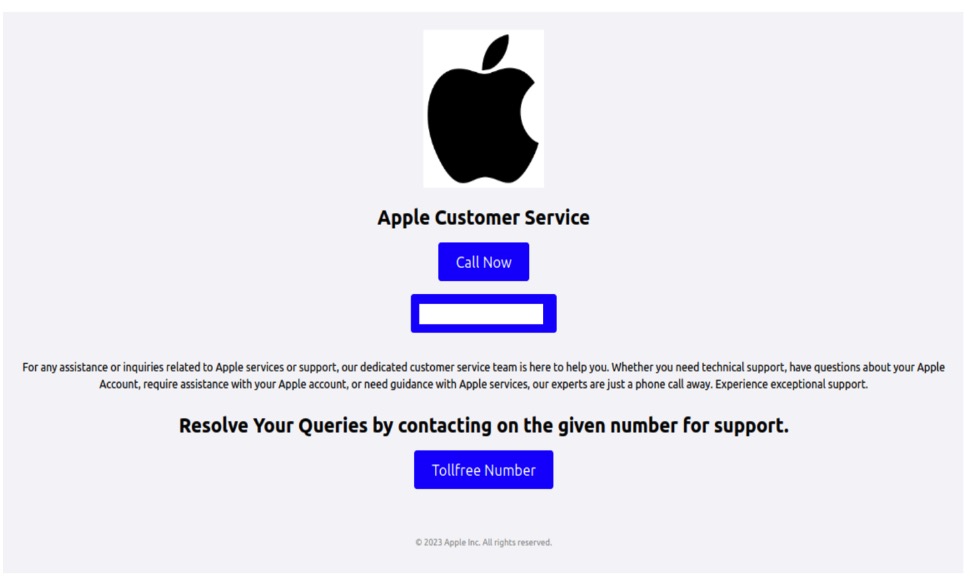
The image below is a screenshot of a fake / malicious / scam site: This particular (fake) Apple sales site used Apple within its URL and name to appear more official. Oddly, this site also sells Samsung Android phones.

The image below is a screenshot of a fake / malicious / scam site: This site, now taken down, is a scam site purporting to sell Nike shoes.
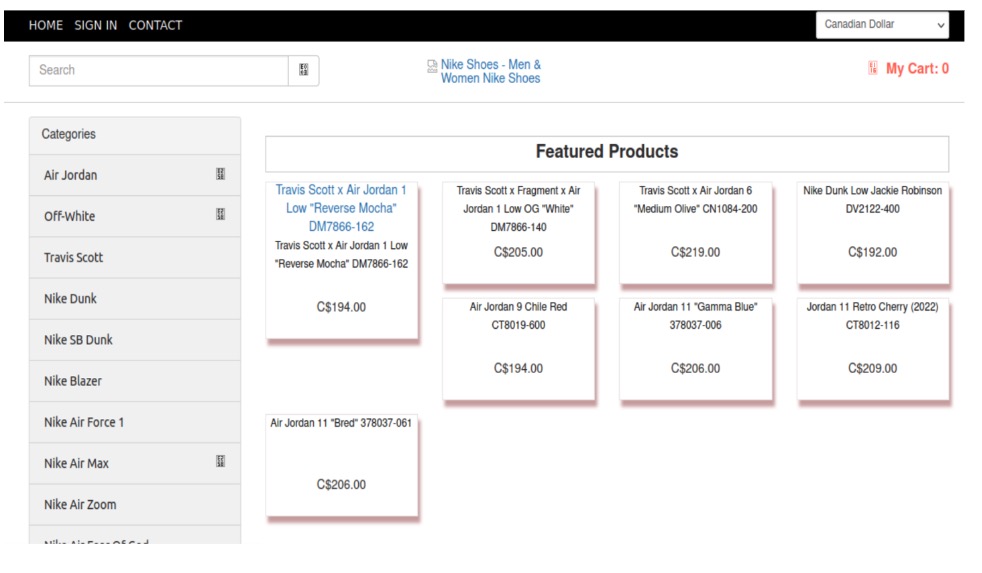
The image below is a screenshot of a fake / malicious / scam site: Louis Vuitton is a popular brand for counterfeit and scams. Particularly their handbags. Here is one site that was entirely focused on Louis Vuitton Handbags.

The image below is a screenshot of a fake / malicious / scam site: This site presents itself as the official Louis Vuitton site selling handbags and clothes.

The image below is a screenshot of a fake / malicious / scam site: This site uses too-good-to-be-true deals on branded items including this Louis Vuitton Bomber jacket.

The image below is a screenshot of a fake / malicious / scam site: Rolex is a popular watch brand for counterfeits and scams. This site acknowledges it sells counterfeits and makes no effort to indicate this on the product.

The post This Holiday Season, Watch Out for These Cyber-Grinch Tricks Used to Scam Holiday Shoppers appeared first on McAfee Blog.

If you think your Gmail account’s been hacked, you’ll want to act. And act quickly.
The fact is that your email has all manner of personal info in there. Receipts, tax correspondence, medical info, and so on. With a hacked account, that info might get deleted, shared, or used against you for identity theft.
Luckily, Google has mechanisms in place to restore a hacked Gmail account. We’ll walk through the steps here — and a few others that can keep you secure in the long term after you have your account back.
Several things can tip you off, including:
With varying degrees of certainty, those are some signs that your account has been hacked.
Also, many people have a Google Account linked with their Gmail password and login. Beyond email, that might include files in Google Drive, photos, a YouTube account, and other features that contain personal info. In those cases, that only increases the potential harm of a hacked account.
Additionally, services like Google Pay and Google Play complicate matters more in the event of a hacked account because they contain financial info.
If you see any unusual changes in those apps or services, that might be a sign of a hacked account as well.
If you think someone else has changed your password or deleted your account, head to Google’s account recovery page. It’ll take you through a multi-step process to restore your account.
With that, you’ll want to do some quick prep. First, do your best to begin the recovery process with a device that you typically use to access your account. Also, if possible, do it in a location where you typically access your account. This provides Google with identifiers that you are who you say you are.
After that, gather up your Gmail account passwords, old and current. The recovery page will ask for them, along with other questions. Do your best to answer each question the very best you can. There’s no penalty for a wrong answer and the more info you can provide, the better.
If you can log into your account, yet worry it’s been hacked, take these steps:
Next, run a virus scan on your device. Your password might have gotten compromised in one of several ways, including malware. This can remove any malware that might be spying on your device (and your passwords).
At this point, create a new password that’s strong and unique. Use at least 14 characters using a mix of upper- and lowercase letters, symbols, and numbers. Or have a password manager do that work for you.
And finally, set two-factor verification on your account if you aren’t already using it. This makes your account far tougher to hack, as two-factor verification requires a unique code to log in. One that only you receive. And just like with your password, never share your unique code. Anyone asking for it is a scammer.
By taking the steps we just covered, you’ve done two important things that can protect you moving forward. One is setting up a strong, unique password. The second is using two-factor verification.
The next thing is to get comprehensive online protection in place. Protection like you’ll find in our McAfee+ plans offers several features that can keep you and your accounts safe.
Once again, your password got compromised one way or another. It could have been spyware on your device. It could have been a phishing attack. It could have been a data breach. The list goes on. However, we refer to it as comprehensive online protection because it’s exactly that. In addition to antivirus, our McAfee+ plans have dozens of features that can protect your devices, identity, and privacy.
For example:
The important thing is this: if you think your Gmail account got hacked, act quickly. You might have much more than just your email linked to that account. Files, photos, and finances might be tied to it as well.
Even if something looks just slightly off, act as if your account got hacked. Log in, change your password, establish two-step verification if you haven’t, and take the other steps mentioned above. Above and beyond your email and all the personal info packed in there, your account can give a hacker access to plenty more.
The post How to Reset Your Gmail Password After Being Hacked appeared first on McAfee Blog.

You crack open your credit card statement and something seems … off. Maybe it’s a couple of small online purchases that make you think, “Hmm, that’s strange.” Or maybe a statement shows up in your mailbox — one for a card that you don’t own at all. That calls for a huge “What the heck???” Sure enough, you’re looking at cases of identity fraud and theft.
And there’s a difference between identity fraud and identity theft. It’s subtle. And because of that, they often get used interchangeably. Each one can really sting but in different ways.
So, put simply, identity fraud involves stealing from an existing account. Identity theft means that someone used your personal info to impersonate you in some way, such as opening new accounts in your name.
Each year, the U.S. Federal Trade Commission (FTC) publishes a data book that collects consumer reports of fraud, identity theft, and other similar crimes. Using the most recent data from the FTC, we can plot what the top forms of identity theft and fraud look like.
Credit cards
By far the top form of identity theft and fraud. As mentioned in the examples above, these can include crooks who string out several small purchases over time. All in the hope that the cardholder will overlook it. It can also include a one-whopper of a purchase for a big-ticket item. Here, the crook knows the card will likely get canceled quickly afterward. It’s a one-and-done deal.
Loans and leases
Second, we have loans and leases. This can range from student loans, personal loans, and auto loans, and to real estate rentals as well. Common across them all is someone impersonating you to take them out or tap into their funds in some way.
Bank accounts
Here, the creation of totally new accounts leads the way in this category. As we described above, that’s a form of identity theft. Yet identity fraud accounts for a noticeable chuck, which includes account takeovers. In these cases, crooks siphon off funds via debit cards, Electronic Funds Transfer (ETF), and other forms of withdrawal and transfer.
ID and government benefits
This covers cases where crooks use stolen personal info to get IDs. That includes driver’s licenses, passports, and other government documentation. Further, this category also encompasses the theft of government-issued benefits ranging from medical assistance to veteran’s pay.
Tax returns
While all forms of identity theft and fraud can pack a punch, this type hits particularly hard because it involves your SSN. Around tax time, scammers with access to SSNs will file bogus returns, all with the aim of claiming the refund for themselves.
Utilities
Largely, this involves people buying cell phones and opening new mobile accounts along with them. Yet it also includes people opening other utilities in other people’s names. Indeed, crooks will scam their way into getting free electricity, water, gas, and yes…cable TV.
Although these forms don’t top the list in terms of reports, they still bear mentioning. They’re serious enough, and they can go undetected for some time before their victims find out.
Medical identity theft
In this form, an imposter receives care, medications, or medical devices in someone else’s name. They might pass off phony documentation to the care provider involved, the insurance company that pays for the care, or a combination of the two. A few things can happen as a result. It can impact the care you can get and the benefits you can use. In extreme cases, the thief’s health info can get mixed in with yours and impact your care. Medical identity theft is a good reason to closely review all the medical and insurance statements you get.
Child identity theft
Imagine your child about to rent a first apartment. The property management company runs a credit check, only to find a horrendous credit rating. But how? An identity thief has been using your child’s identity for years now. After all, what parent thinks, “I really should run a credit report on my kindergartener.” And that’s fair. However, signing up your child for identity is a sound move. It can help spot if your child’s identity got stolen.
1) Notify the companies and institutions involved and consider a credit freeze.
Whether you spot a curious charge on your bank statement or you discover what looks like a fraudulent account in your credit monitoring service, let the bank or business involved know you suspect fraud. With a visit to their website, you can track down the appropriate number to call and get the investigation process started.
In the meantime, consider putting a security freeze in place. A security freeze service prevents others from opening new credit, bank, and utility accounts in your name. It won’t hit your credit score, and you can unfreeze it when needed. You’ll find this feature in our McAfee+ plans as well.
2) File a police report.
Some businesses will require you to file a local police report to acquire a case number to complete your claim. Beyond that, filing a report is still a good idea. Identity theft is still theft, and reporting it provides an official record of it.
Should your case of identity theft lead to someone impersonating you or committing a crime in your name, filing a police report right away can help you clear your name down the road. Likewise, save any evidence you have, such as statements or documents associated with the theft. They can help you clean up your record as well.
3) Contact the Federal Trade Commission (FTC).
The FTC’s identity theft website is a fantastic resource should you find yourself in need. Above and beyond simply reporting the theft, the FTC can provide you with a step-by-step recovery plan—and even walk you through the process if you create an account with them. Additionally, reporting theft to the FTC can prove helpful if debtors come knocking to collect on any bogus charges in your name. You can provide them with a copy of your FTC report and ask them to stop.
4) Contact the IRS, if needed.
If you receive a notice from the IRS that someone used your identity to file a tax return in your name, follow the information provided by the IRS in the notice. From there, you can file an identity theft affidavit with the IRS. If the notice mentions that you were paid by an employer you don’t know, contact that employer as well and let them know of possible fraud — namely that someone has stolen your identity and that you don’t truly work for them.
Also, be aware that the IRS has specific guidelines as to how and when they will contact you. As a rule, they will most likely contact you via physical mail delivered by the U.S. Postal Service. (They won’t call, nor will they call and apply harassing pressure tactics — only scammers do that.) Identity-based tax scams are a topic all of their own, and for more on it, you can check out this article on tax scams and how to avoid them.
5) Continue to monitor your credit report, invoices, and statements.
Another downside of identity theft is that it can mark the start of a long, drawn-out affair. One instance of theft can possibly lead to another, so even what may appear to be an isolated bad charge on your credit card calls for keeping an eye on your identity. Many of the tools you would use up to this point still apply, such as checking up on your credit reports, maintaining fraud alerts as needed, in addition to reviewing your accounts closely.
Several features in our McAfee+ plans can do this work, and quite a bit more, for you:
The post What Are the 6 Types of Identity Theft appeared first on McAfee Blog.

For millions of people, it’s not a workday without it — video conferencing. And plenty of business gets done that way, which has made conferencing a target for hackers. That then begs the important question, how secure is video conferencing?
The answer is pretty secure if you’re using a reputable service. Yet you can take further steps to keep hackers and party crashers out of your meetings.
Hackers and party crashers are likely motivated by one of two things: financial gain or mischief.
Given that some meetings involve confidential or sensitive info, someone might have financial motivation to join in, spy on, or record the meeting. Recently, we saw the lengths at least one AI company went to when it spied on a competitor’s video conference call.[i]
And of course, some bad actors want to cause a disruption. As we saw in recent years, they’ll barge right into a meeting and create a ruckus with rude speech and other antics.
Falling somewhere in between, some hackers might try to intrude on a meeting and slip a malware-laden attachment into chat.[ii] For one, that can lead to a major disruption. And in a business context, financial disruption as well.
How do they pull it off? The typical avenues of attack apply. They might use stolen or hijacked accounts. The meeting was inadvertently set to “public,” allowing anyone with a link to join. Otherwise, they might compromise a victim’s device to piggyback their way in.
Use a service with end-to-end encryption.
Put simply, end-to-end encryption provides a solid defense against prying eyes. With it in place, this form of encryption makes it particularly difficult for hackers to tap into the call and the data shared within it. Secure video conferencing should use 256-bit AES GCM encryption for audio and video, and for sharing of screens, whiteboard apps, and the like. On a related note, read the service’s privacy policy and ensure that its privacy, security, and data measures fit your needs.
Make your meetings private and protect them with a password.
Keep the uninvited out. First, setting your meeting to private (invitees only) will help keep things secure. Some apps also provide a notification to the meeting organizer when an invite gets forwarded. Use that feature if it’s available. Also, a password provides another hurdle for a hacker or bad actor to clear. Use a fresh one for each meeting.
Use the waiting room.
Many services put attendees into a waiting room before they enter the meeting proper. Use this feature to control who comes in and out.
Block users from taking control of the screen.
Welcome or unwelcome, you can keep guests from taking over the screen. Select the option to block everyone except the host (you) from screen sharing.
Turn on automatic updates on your conferencing app.
By turning on automatic updates, you’ll get the latest security patches and enhancements for your video conferencing tool as soon as they become available.
Get wise to phishing scams.
Some interlopers make it into meetings by impersonating others. Just as bad actors use phishing emails and texts to steal personal financial info, they’ll use them to steal company credentials as well. Our Phishing Scam Protection Guide can show you how to steer clear of these attacks.
Use online protection software.
Comprehensive online protection software like ours can make for safer calls in several ways. For one, it protects you against malware attacks, such as if a bad actor tries to slip a sketchy download into your meeting. Further, it includes a password manager that creates and stores strong, unique passwords securely. This can help increase the security of your video conferencing account.
This is a new one. AI deepfake technology continues to evolve, we find ourselves at the point where scammers can create AI imposters in real time.
We’ve seen them use this technology in romance scams, where scammers take on entirely new looks and voices on video calls. And we’ve seen at least one group of scammers bilk a company out of $25 million with deepfaked executives on a call.[iii]
Strange as it might sound, this kind of deepfake technology is possible today. And realizing that fact is the first step toward prevention. Next, that calls for extra scrutiny.
Any time-sensitive info or sums of money are involved, get confirmation of the request. Place a phone call to the person after receiving the request to ensure it’s indeed legitimate. Better yet, meet the individual in person if possible. In all, contact them outside the email, message, or call that initially made the request to ensure you’re not dealing with an imposter.
With the right provider and right steps in place, video calls can be quite secure. Use a solution that offers end-to-end encryption, keep your app updated for the latest security measures, and lock down the app’s security settings. Also, recognize that AI has changed the way we look at just about everything online — including people on the other side of the screen. As we’ve seen, AI imposters on calls now fall into the realm of possibility. A costly one at that.
[i] https://www.nytimes.com/2023/08/07/technology/ai-start-ups-competition.html
[ii] https://www.pcmag.com/news/hackers-circulate-malware-by-breaking-into-microsoft-teams-meetings
[iii] https://www.cnn.com/2024/02/04/asia/deepfake-cfo-scam-hong-kong-intl-hnk/index.html
The post How Secure is Video Conferencing? appeared first on McAfee Blog.

Before your phone gets lost or stolen, put some basic steps in place.
You’ll want to act quickly, so preparation is everything. With the right measures, you can find it, recover it, or even erase it if needed. These steps can get you set up so you can do exactly that.
Lock your phone.
Locking your phone is one of the most basic smartphone security measures you can take. Trouble is, few of us do it. Our recent global research showed that only 56% of adults said that they protect their smartphone with a password, passcode, or other form of lock.[i] In effect, an unlocked phone is an open book to anyone who finds or steals a phone
Setting up a lock screen is easy. It’s a simple feature found on iOS and Android devices. iPhones and Androids have an auto-lock feature that locks your phone after a certain period of inactivity. Keep this time on the low end, one minute or less, to help prevent unauthorized access.
We suggest using a six-digit PIN or passcode rather than using a gesture to unlock your phone. They’re more complex and secure. Researchers proved as much with a little “shoulder surfing” test. They looked at how well one group of subjects could unlock a phone after observing the way another group of subjects unlocked it.[ii]
Turn on “Find My Phone.”
Another powerful tool you have at your disposal is the Find My Phone feature made possible thanks to GPS technology. The “find my” feature can help you pinpoint your phone if your lost or stolen phone has an active data or Wi-Fi connection and has its GPS location services enabled. Even if the phone gets powered down or loses connection, it can guide you to its last known location.
Setting up this feature is easy. Apple offers a comprehensive web page on how to enable and use their “Find My” feature for phones (and other devices too). Android users can get a step-by-step walkthrough on Google’s Android support page as well.
Back up your stuff in the cloud.
Thanks to cloud storage, you might be able to recover your photos, files, apps, notes, contact info, and more if your phone is lost or stolen. Android owners can learn how to set up cloud backup with Google Drive here, and iPhone users can learn the same for iCloud here.
Write down your phone’s unique ID number.
Here are a couple of acronyms. IMEI (International Mobile Equipment Identity) or MEID (Mobile Equipment Identifier) are two types of unique ID numbers assigned to smartphones. Find yours and write it down. In case of loss or theft, your mobile carrier, police department, or insurance provider might ask for the info to assist in its return or reimbursement for loss.
Beyond digital security measures, plenty of loss and theft prevention falls on you. Treat your phone like the desirable item it is. That’s a big step when it comes to preventing theft.
Keep your phone close.
And by close, we mean on your person. It’s easy to leave your phone on the table at a coffee shop, on a desk in a shared workspace, or on a counter when you’re shopping. Thieves might jump on any of these opportunities for a quick snatch-and-grab. You’re better off with your phone in your pocket or zipped up in a bag that you keep close.
Secure your bags and the devices you carry in them.
Enterprising thieves will find a way. They’ll snatch your bag while you’re not looking. Or they might even slice into it with a knife to get what’s inside, like your phone.
Keep your bag or backpack close. If you’re stopping to grab a bite to eat, sling the handles through a chair leg. If you have a strong metal carabiner, you can use that too. Securing your bag like that can make it much tougher for a thief to walk by and swipe it. For extra security, look into a slash-resistant bag.
If you have a credit card and ID holder attached to the back of your phone, you might want to remove your cards from it. That way, if your phone gets snatched, those important cards won’t get snatched as well.
In the event of your phone getting lost or stolen, a combination of device tracking, device locking, and remote erasing can help protect your phone and the data on it.
Different device manufacturers have different ways of going about it. But the result is the same — you can prevent others from using your phone, and even erase it if you’re truly worried that it’s in the wrong hands or gone for good. Apple provides iOS users with a step-by-step guide, and Google offers up a guide for Android users as well.
Apple’s Find My app takes things a step further. Beyond locating a lost phone or wiping it, Find My can also mark the item as lost, notify you if you’ve left it behind, or trigger a sound to help you locate it. (A huge boon in that couch cushion scenario!) Drop by Apple’s page dedicated to the Find My app for more details on what you can do on what devices, along with instructions how.
With preparation and prevention, you can give yourself reassurance if your phone gets lost or stolen. You have plenty of recovery options, in addition to plenty of ways to prevent bad actors from getting their hands on the sensitive info you keep on it.
[i] https://www.mcafee.com/content/dam/consumer/en-us/docs/reports/rp-connected-family-study-2022-global.pdf
[ii] https://arxiv.org/abs/1709.04959
The post What Should I do If My Phone Gets Stolen or Lost? appeared first on McAfee Blog.
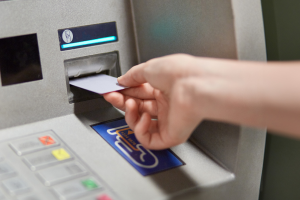
Ever take a look at an ATM and feel like something’s off? You might have come across an ATM skimmer.
It works like this… A crook tampers with an ATM by attaching a physical device that skims card info as cards people grab or deposit money. From there, a keypad overlay or tiny pinhole camera captures your PIN as people tap it in. And with that info, the crook has everything they need to create several counterfeit cards.
Of course, that thief has to transfer that info. In some cases, the thief creeps back, removes the skimming device, downloads your data, and burns it to a blank ATM card. More sophisticated skimmers are connected, so thieves can download stolen info from the skimmer and then use that info to buy stuff online. Either way, a skimmer can take a big chunk out of your bank account.
However, you have ways of spotting these sketchy ATMs. And yet, there are more ways to protect your finances if you fall victim to a carefully concealed skimmer.
Spotting a hacked ATM can get a bit tricky, yet you can look for a few signs. Generally speaking, ATMs are sturdy by design. If a card reader or keypad wiggles at all or the keypad feels too spongy or sticks when you tap the buttons, you might be looking at a hacked ATM. Also keep an eye out for extra pieces of plastic stuck to the ATM, which can be places where a crook has concealed a camera. Often, they’ll disguise cameras in brochure holders and overhead lights.
Another clue of a hacked ATM — scanners and other components that don’t match the color and style of the machine. In all, anything that looks tacked on or out of place gives you a good reason to use another ATM.
To protect yourself further, follow these tips:
Be choosy.
While out and about, consider using ATMs installed at a bank. These are watched more closely than ATMs in public places, which makes them harder to tamper with.
Cover the keypad when entering your PIN.
Thieves need your card number and your PIN to access your account with a copycat card. By covering the keypad, you prevent cameras and onlookers from seeing your PIN.
Check your bank and credit card statements often.
If your card does get skimmed, acting quickly counts. Thieves can quickly rack up purchases and out a chunk of your account. Banks typically watch for fraud and will contact you about unusual activity.
Better yet, you can keep a closer eye on your accounts yourself. Our McAfee+ plans offer several types of account and transaction monitoring. Together, they can alert to strange transactions across bank, credit, retirement, and other accounts. They can also alert you if any of your info at the bank gets changed, which helps prevent account takeovers.
The post What is ATM Skimming? appeared first on McAfee Blog.

Identity theft is a pervasive threat in today’s digital age, with various forms that can wreak havoc on individuals’ lives. In 2023, the Federal Trade Commission’s Consumer Sentinel Network received more than 5.39 million consumer reports, with 19% of those reports attributed to identity theft.
Understanding the types of identity theft is crucial for safeguarding personal information and financial well-being. From the insidious tactics of new account fraud to the alarming consequences of medical identity theft, each method poses distinct risks and challenges. Here are six types of the most common forms of identity theft.
New Account Fraud
Using another’s personal identifying information to obtain products and services using that person’s good credit standing. This fraud often requires the use of the victim’s Social Security number. Opening new utility, cell phone, and/or credit card accounts are the most prevalent forms of new account fraud.
Account Takeover Fraud
Using another person’s account numbers, such as a credit card number, to obtain products and services using that person’s existing accounts or extracting funds from a person’s bank account.
Criminal Identity Theft
Someone commits a crime under another person’s name. The thief, in the act of the crime or upon arrest, poses as the identity theft victim. Often the perpetrator will have a fake ID with the victim’s information but the imposter’s picture.
Medical Identity Theft
Medical identity theft occurs when someone uses a person’s name and/or insurance information—without the person’s knowledge or consent—to obtain medical services or goods, or to make false claims for medical goods or services. Medical identity theft frequently results in erroneous entries being put into the victim’s medical records, which in turn may lead to inappropriate and potentially life-threatening decisions by medical staff.
Business or Commercial Identity Theft
Using a business’s name to obtain credit or even billing those businesses’ clients for products and services. Perpetrators who commit business identity theft are often insiders — current or ex-employees — with direct access to operational documentation, who pad the books in favor of their scheming.
Identity Cloning
This type encompasses all forms of identity theft. The thief is actually living and functioning as the victim on purpose. They may be hiding in plain sight due to the fact they are running from the law, evading child support or they could be mentally ill.
It is important to observe basic security precautions to protect your identity. To protect your identity from theft, regularly monitor your financial accounts for suspicious activity and report any discrepancies immediately. Safeguard personal information by avoiding sharing sensitive data on insecure websites or over unsecured Wi-Fi networks. Utilize strong, unique passwords for each online account and enable multi-factor authentication whenever possible. Finally, be cautious of phishing attempts and never click on suspicious links or provide personal information in response to unsolicited communications.
Check out our blog post on the top signs of identity theft for further advice on what to do if you feel you may be at risk. Also consider an identity theft protection product, like McAfee+, that can provide greater peace of mind through 24/7 identity monitoring and alerts, plus up to $2 million in identity theft coverage.
The post How to Identify the Different Forms of Identity Theft appeared first on McAfee Blog.

In today’s interconnected world, our mobile devices serve as essential tools for communication, productivity, and entertainment. However, for some tech-savvy users, the allure of unlocking the full potential of their devices through jailbreaking (for iOS) or rooting (for Android) can be tempting. While these processes offer users greater control and customization over their devices, they also raise significant questions about security implications.
To “jailbreak” means to allow the phone’s owner to gain full access to the root of the operating system and access all the features. Jailbreaking is the process of removing the limitations imposed by Apple and associated carriers on devices running the iOS operating system. Jailbroken phones came into the mainstream when Apple first released their iPhone and it was only on AT&T’s network. Users who wanted to use an iPhone with other carriers were not able to unless they had a jailbroken iPhone.
Similar to jailbreaking, “rooting” is the term for the process of removing the limitations on a mobile or tablet running the Android operating system. By gaining privileged control, often referred to as “root access,” over an Android device’s operating system, users can modify system files, remove pre-installed bloatware, install custom ROMs, and unlock features not accessible on stock devices.
Rooting or jailbreaking grants users deeper access to the device’s operating system, allowing for extensive customization of the user interface, system settings, and even hardware functionality. Advanced users can optimize system performance, remove unnecessary bloatware, and tweak settings to improve battery life, speed, and responsiveness.
However, hacking your device potentially opens security holes that may have not been readily apparent or undermines the device’s built-in security measures. Jailbroken and rooted phones are much more susceptible to viruses and malware because users can avoid Apple and Google application vetting processes that help ensure users are downloading virus-free apps.
In addition to security vulnerabilities, hacking your device may lead to a voided manufacturer’s warranty, leaving you without official support for repairs or replacements. Altering the device’s operating system can also lead to instability, crashes, and performance issues, especially if incompatible software or modifications are installed.
While rooting or jailbreaking may offer users enticing opportunities for customization and optimization of their mobile devices, the associated risks cannot be overlooked. By circumventing built-in security measures, users expose their devices to potential security vulnerabilities, making them more susceptible to viruses and malware. Ultimately, the decision to root or jailbreak a mobile device should be made with careful consideration of the trade-offs involved, as the security risks often outweigh the benefits.
When thinking about mobile security risks, consider adding reputable mobile security software to your device to augment the built-in security measures. These security solutions provide real-time scanning and threat detection capabilities, helping to safeguard sensitive data and maintain the integrity of the device’s operating system.
The post How Does Jailbreaking Or Rooting Affect My Mobile Device Security? appeared first on McAfee Blog.

“Vishing” occurs when criminals cold-call victims and attempt to persuade them to divulge personal information over the phone. These scammers are generally after credit card numbers and personal identifying information, which can then be used to commit financial theft. Vishing can occur both on your landline phone or via your cell phone.
The term is a combination of “voice,” and “phishing,” which is the use of spoofed emails to trick targets into clicking malicious links. Rather than email, vishing generally relies on automated phone calls that instruct targets to provide account numbers. Techniques scammers use to get your phone numbers include:
Once vishers have phone numbers, they employ various strategies to deceive their targets and obtain valuable personal information:
To protect yourself from vishing scams, you should:
Staying vigilant and informed is your best defense against vishing scams. By verifying caller identities, being skeptical of unsolicited requests for personal information, and using call-blocking tools, you can significantly reduce your risk of falling victim to these deceptive practices. Additionally, investing in identity theft protection services can provide an extra layer of security. These services monitor your personal information for suspicious activity and offer assistance in recovering from identity theft, giving you peace of mind in an increasingly digital world. Remember, proactive measures and awareness are key to safeguarding your personal information against vishing threats.
The post How to Protect Yourself from Vishing appeared first on McAfee Blog.

By now you’ve probably heard of the term “phishing”—when scammers try to fool you into revealing your personal info or sending money, usually via email — but what about “vishing”? Vishing, or voice phishing, is basically the same practice, but done by phone.
There are a few reasons why it’s important for you to know about vishing. First off, voice phishing scams are prevalent and growing. A common example around tax season is the IRS scam, where fraudsters make threatening calls to taxpayers pretending to be IRS agents and demanding money for back taxes. Another popular example is the phony tech support scam, in which a scammer calls you claiming that they represent a security provider.
The scammers might say they’ve noticed a problem with your computer or device and want money to fix the problem, or even request direct access to your machine. They might also ask you to download software to do a “security scan” just so they can get you to install a piece of malware that steals your personal info. They might even try to sell you a worthless computer warranty or offer a phony refund.
These kinds of attacks can be very persuasive because the scammers employ “social engineering” techniques. This involves plays on emotion, urgency, authority, and even sometimes threats. The end result, scammers manipulate their victims into doing something for fraudulent purposes. Because scammers can reach you at any time on your most private device, your smartphone, it can feel more direct and personal.
Vishing scams don’t always require a phone call from a real person. Often, scammers use a generic or targeted recording, claiming to be from your bank or credit union. For instance, they might ask you to enter your bank account number or other personal details, which opens you up to identity theft.
Increasingly, scammers use AI tools in voice cloning attacks. With readily available voice cloning apps, scammers can replicate someone else’s voice with remarkable accuracy. While initially developed for benign purposes such as voice assistants and entertainment, scammers now use voice cloning tools to exploit unsuspecting victims.
The incoming number might even appear to have come from your bank, thanks to a trick called “caller ID spoofing,” which allows scammers to fake the origin of the call. They can do this by using Voice over Internet Protocol (VoIP) technology, which connects calls over the internet instead of traditional phone circuits, allowing them to easily assign incoming phone numbers.
Don’t risk losing your money or valuable personal info to these scams. Here’s how to avoid vishing attacks:
The post How to Avoid Being Phished by Your Phone appeared first on McAfee Blog.

I think I could count on one hand the people I know who have NOT had their email hacked. Maybe they found a four-leaf clover when they were kids! Email hacking is one of the very unfortunate downsides of living in our connected, digital world. And it usually occurs as a result of a data breach – a situation that even the savviest tech experts find themselves in.
In simple terms, a data breach happens when personal information is accessed, disclosed without permission, or lost. Companies, organisations, and government departments of any size can be affected. Data stolen can include customer login details (email addresses and passwords), credit card numbers, identifying IDs of customers e.g. driver’s license numbers and/or passport numbers, confidential customer information, company strategy, or even matters of national security.
Data breaches have made headlines, particularly over the last few years. When the Optus and Medibank data breaches hit the news in 2022 affecting almost 10 million Aussies apiece, we were all shaken. But then when Aussie finance company Latitude was affected in 2023 with a whopping 14 million people from both Australia and New Zealand, it almost felt inevitable that by now, most of us would have been impacted.
The reality is that data breaches have been happening for years. In fact, the largest data breach in Australian history happened in 2019 to the online design site Canva which affected 139 million users globally. In short, it can happen to anyone, and the chances are you may have already been affected.
The sole objective of a hacker is to get their hands on your data. Any information that you share in your email account can be very valuable to them. Why do they want your data, you ask? It’s simple really – so they can cash in!
Some will keep the juicy stuff for themselves – passwords or logins to government departments or large companies they may want to ’target’ with the aim of extracting valuable data and/or funds. The more sophisticated ones will sell your details including name, telephone, email address, and credit card details to cash in on the dark web. They often do this in batches. Some experts believe they can get as much as AU$250 for a full set of details including credit cards. So, you can see why they’d be interested in you.
The other reason why hackers will be interested in your email address and password is that many of us re-use our login details across our other online accounts. Once they’ve got their hands on your email credentials, they may be able to access your online banking and investment accounts, if you use the same credentials everywhere. So, you can see why I harp on about using a unique password for every online account!
There is a plethora of statistics on just how big this issue is – all of them concerning. According to the Australian Institute of Criminology, of all the country’s cybercrime reports in 2024, about 21.9% involved identity theft and misuse. The Australian Bureau of Statistics adds that the identity theft victimisation rate has steadily increased from 0.8% to 1.2% from 2021 to 2024, respectively.
Meanwhile, The Australian Government revealed that at least one cybercrime is reported every 6 minutes, with business email compromise alone costing the national economy up to $84 million in losses. Regardless of which statistic you choose to focus on, we have a big issue on our hands.
Hackers use a range of techniques—some highly sophisticated, others deceptively simple—to gain access. It is important to know how these attacks happen so you can stay ahead and prevent them.
Yes, absolutely. An email account is often the central hub of your digital life. Once a cybercriminal controls it, they can initiate password resets for your other online accounts, including banking, shopping, and social media. They can intercept sensitive information sent to you, such as financial statements or medical records.
With enough information gathered from your emails, they can commit identity theft, apply for credit in your name, or access other sensitive services. If you suspect your email was hacked, it’s crucial to monitor your financial statements and consider placing a fraud alert with credit bureaus.
If you find yourself a victim of email hacking, these are a few very important steps you need to take. Fast.
Using a separate, clean device, this is the very first thing you must do to ensure the hacker can’t get back into your account. It is essential that your new password is complex and totally unrelated to previous passwords. Always use random words and characters, a passphrase with a variety of upper and lower cases, and throw in some symbols and numbers.
I really like the idea of a crazy, nonsensical sentence – easier to remember and harder to crack! But, better still, get yourself a password manager that will create a password that no human would be capable of creating. If you find the hacker has locked you out of your account by changing your password, you will need to reset the password by clicking on the ‘Forgot My Password’ link.
This is time-consuming, but essential. Ensure you change any other accounts that use the same username and password as your compromised email. Hackers love the fact that many people use the same logins for multiple accounts, so it is guaranteed they will try your info in other email applications and sites such as PayPal, Amazon, Netflix – you name it!
Once the dust has settled, review your password strategy for all your online accounts. A best practice is to ensure every online account has its own unique and complex password.
Most email services have a security feature that lets you remotely log out of all active sessions. Once you’ve changed your password, signing out from your email account also signs out the hacker and forces them to log-in with the new password, which fortunately they do not know. These, combined with two- or multi-factor authentication, will help you to regain control of your account and prevent further compromise.
A big part of the hacker’s strategy is to get their claws into your address book to hook others as well. Send a message to all your email contacts as soon as possible so they know to avoid opening any emails—most likely loaded with malware—that have come from you.
Two-factor or multi-factor authentication may seem like an additional, inconvenient step to your login, but it also adds another layer of protection. Enabling this means you will need a special one-time-use code to log in, aside from your password. This is sent to your mobile phone or generated via an authenticator app. So worthwhile!
It is common for hackers to modify your email settings so that a copy of every email you receive is automatically forwarded to them. Not only can they monitor your logins to other sites; they can also keep a watchful eye on any particularly juicy personal information. So, check your mail forwarding settings to ensure no unexpected email addresses have been added.
Also, ensure your ‘reply to’ email address is actually yours. Hackers have been known to create an email address that looks similar to yours, so that when someone replies, it will go straight to their account, not yours.
Don’t forget to check your email signature to ensure nothing spammy has been added, as well as your recovery phone number and alternate email address. Hackers also change these to maintain control. Update them to your own secure details.
Regularly scanning your devices for unwanted invaders is essential. If you find anything, please ensure it is addressed, and then change your email password again. If you don’t have antivirus software, please invest in it.
Comprehensive security software will provide you with a digital shield for your online life, protecting all your devices – including your smartphone – from viruses and malware. Some services also include a password manager to help you generate and store unique passwords for all your accounts.
If you have been hacked several times and your email provider isn’t mitigating the amount of spam you are receiving, consider starting afresh. Do not, however, delete your old email address because email providers are known to recycle old email addresses. This means a hacker could spam every site they can find with a ‘forgot my password’ request and try to impersonate you and steal your identity.
Your email is an important part of your online identity so being vigilant and addressing any fallout from hacking is essential for your digital reputation. Even though it may feel that getting hacked is inevitable, you can definitely reduce your risk by installing some good-quality security software on all your devices.
Trusted and reliable comprehensive security software will alert you when visiting risky websites, warn you when a download looks dodgy, and block annoying and dangerous emails with anti-spam technology. It makes sense really – if you don’t receive the dodgy phishing email – you can’t click on it. Smart!
Finally, don’t forget that hackers love social media – particularly those of us who overshare on it. So, before you post details of your adorable new kitten, remember it may just provide the perfect clue for a hacker trying to guess your email password!
Reporting an email hack is a crucial step to create a necessary paper trail for disputes with banks or credit agencies. When reporting, gather evidence such as screenshots of suspicious activity, unrecognized login locations and times, and any phishing emails you received. This information can be vital for the investigation.
Generally, no. Deleting the account can cause more problems than it solves. Many online services are linked to that email, and deleting it means you lose the ability to receive password reset links and security notifications for those accounts.
More importantly, some email providers recycle deleted addresses, meaning a hacker could potentially re-register your old email address and use it to impersonate you and take over your linked accounts.
The better course of action is to regain control, thoroughly secure the account with a new password and multi-factor authentication, and clean up any damage. Only consider migrating to a new email address after you have fully secured the old one.
Each email provider has a specific, structured process for account recovery. It is vital to only use the official recovery pages provided by the service and be wary of scam websites or third-party services that claim they can recover your account for a fee. Below are the official steps of the major providers that you can follow.
Your email account is the master key to your digital kingdom, and protecting it is more critical than ever since many of your other accounts are connected with your email. Realizing “my email has been hacked” is a stressful experience, but taking swift and correct action can significantly limit the damage.
By following the recovery steps and adopting strong, ongoing security habits like using a password manager and enabling multi-factor authentication, you can turn a potential crisis into a lesson in digital resilience. Stay vigilant, stay proactive, and keep your digital front door securely locked.
To add another wall of defense, consider investing in a trusted and reliable comprehensive security software like McAfee+. Our solution will help you dodge hacking attempts by alerting you when visiting risky websites, or downloading questionable apps, and blocking malicious emails with anti-spam technology.
The post What to Do If Your Email Is Hacked appeared first on McAfee Blog.

There are now over 5 billion active social media users worldwide, representing 62.3% of the global population. While social networks serve as valuable tools for staying connected with loved ones and documenting life events, the ease of sharing information raises concerns. With a mere few clicks, posts and messages can inadvertently divulge significant personal details, potentially compromising privacy and leaving individuals vulnerable to identity theft. That’s why it’s crucial to make sure you’ve got the know-how to keep your privacy protected while using these platforms.
To empower you in this digital age, we’ve compiled a comprehensive guide featuring ten essential tips to fortify your online security and preserve your privacy on social networks:
Whether you’re a seasoned social media user or just dipping your toes into the digital waters, these strategies will equip you with the knowledge and tools needed to safeguard your online identity effectively. With the added support of McAfee+, you can ensure an extra layer of security to keep your online presence more secure and private through advanced privacy features, 24/7 identity monitoring and alerts, and real-time protection against viruses, hackers, and risky links.
The post How to Protect Yourself on Social Networks appeared first on McAfee Blog.

In the hands of a thief, your Social Security Number is the master key to your identity.
With a Social Security Number (SSN), a thief can unlock everything from credit history and credit line to tax refunds and medical care. In extreme cases, thieves can use it to impersonate others. So, if you suspect your number is lost or stolen, it’s important to report identity theft to Social Security right away.
Part of what makes an SSN so powerful in identity theft is that there’s only one like it. Unlike a compromised credit card, you can’t hop on the phone and get a replacement. No question, the theft of your SSN has serious implications. If you suspect it, report it. So, let’s take a look at how it can happen and how you can report identity theft to Social Security if it does.
Yes. Sort of. The Social Security Administration can assign a new SSN in a limited number of cases. However, per the SSA, “When we assign a different Social Security number, we do not destroy the original number. We cross-refer the new number with the original number to make sure the person receives credit for all earnings under both numbers.”
In other words, your SSN is effectively for forever, which means if it’s stolen, you’re still faced with clearing up any of the malicious activity associated with the theft potentially for quite some time. That’s yet another reason why the protection of your SSN deserves particular attention.
There are several ways an SSN can end up with a thief. Some involve physical theft, and others can take the digital route. To what extent are SSNs at risk? Notably, there was the Equifax breach of 2017, which exposed some 147 million SSNs. Yet just because an SSN has been potentially exposed does not mean that an identity crime has been committed with it.
So, let’s start with the basics: how do SSNs get stolen or exposed?
That’s quite the list. Broadly speaking, the examples above give good reasons for keeping your SSN as private and secure as possible. With that, it’s helpful to know that there are only a handful of situations where your SSN is required for legitimate purposes, which can help you make decisions about how and when to give it out. The list of required cases is relatively short, such as:
You’ll notice that places like doctor’s offices and other businesses are not listed here, though they’ll often request an SSN for identification purposes. While there’s no law preventing them from asking you for that information, they may refuse to work with you if you do not provide that info. In such cases, ask what the SSN would be used for and if there is another form of identification that they can use instead. In all, your SSN is uniquely yours, so be extremely cautious in order to minimize its potential exposure to theft.
Let’s say you spot something unusual on your credit report or get a notification that someone has filed a tax return on your behalf without your knowledge. These are possible signs that your identity, if not your SSN, is in jeopardy, which means it’s time to act right away using the steps below:
1. Report the theft to local and federal authorities.
File a police report and a Federal Trade Commission (FTC) Identity Theft Report. This will help in case someone uses your Social Security number to commit fraud since it will provide a legal record of the theft. The FTC can also assist by guiding you through the identity theft recovery process as well. Their site really is an excellent resource.
2. Contact the businesses involved.
Get in touch with the fraud department at each of the businesses where you suspect theft has taken place, let them know of your situation, and follow the steps they provide. With your police and FTC reports, you will already have a couple of vital pieces of information that can help you clear your name.
3. Reach the Social Security Administration and the IRS.
Check your Social Security account to see if someone has gotten a job and used your SSN for employment purposes. Reviewing earnings associated with your SSN can uncover fraudulent use. You can also contact the Social Security Fraud Hotline at (800) 269-0271 or reach out to your local SSA office for further, ongoing assistance. Likewise, contact the Internal Revenue Service at (800) 908-4490 to report the theft and help prevent someone from submitting a tax return in your name.
As we’ve talked about in some of my other blog posts, identity theft can be a long-term problem where follow-up instances of theft can crop up over time. However, there are a few steps you can take to minimize the damage and ensure it doesn’t happen again. I cover several of those steps in detail in this blog here, yet let’s take a look at a few of the top items as they relate to SSN theft:
Consider placing a fraud alert.
By placing a fraud alert, you can make it harder for thieves to open accounts in your name. Place it with one of the three major credit bureaus (Experian, TransUnion, Equifax), and they will notify the other two. During the year-long fraud alert period, it will require businesses to verify your identity before issuing new credit in your name.
Look into an all-out credit freeze.
A full credit freeze is in place until you lift it and will prohibit creditors from pulling your credit report altogether. This can help stop thieves dead in their tracks since approving credit requires pulling a report. However, this applies to legitimate inquiries, including any that you make, like opening a new loan or signing up for a credit card. If that’s the case, you’ll need to take extra steps as directed by the particular institution or lender. Unlike the fraud alert, you’ll need to notify each of the three major credit bureaus (Experian, TransUnion, Equifax) when you want the freeze lifted.
Monitor your credit reports.
Once a week you can access a free credit report from Experian, TransUnion, and Equifax. Doing so will allow you to spot any future discrepancies and offer you options for correcting them.
Sign up for an identity protection service.
Using a service to help protect your identity can monitor several types of personally identifiable information and alert you of potentially unauthorized use. Our own Identity Protection Service will do all this and more, like offering guided help to neutralize threats and prevent theft from happening again. You can set it up on your computers and smartphone to stay in the know, address issues immediately, and keep your identity secured.
Of all the forms of identity theft, the theft of a Social Security Number is certainly one of the most potentially painful because it can unlock so many vital aspects of your life. It’s uniquely you, even more than your name alone – at least in the eyes of creditors, banks, insurance companies, criminal records, etc. Your SSN calls for extra protection, and if you have any concerns that it may have been lost or stolen, don’t hesitate to spring into action.
The post How to Report Identity Theft to Social Security appeared first on McAfee Blog.

It’s that time of year again – tax season! Whether you’ve already filed in the hopes of an early refund or have yet to start the process, one thing is for sure: cybercriminals will certainly use tax season as a means to get victims to give up their personal and financial information. This time of year is advantageous for malicious actors since the IRS and tax preparers are some of the few people who actually need your personal data. As a result, consumers are targeted with various scams impersonating trusted sources like the IRS or DIY tax software companies. Fortunately, every year the IRS outlines the most prevalent tax scams, such as voice phishing, email phishing, and fake tax software scams. Let’s explore the details of these threats.
So, how do cybercriminals use voice phishing to impersonate the IRS? Voice phishing, a form of criminal phone fraud, uses social engineering tactics to gain access to victims’ personal and financial information. For tax scams, criminals will make unsolicited calls posing as the IRS and leave voicemails requesting an immediate callback. The crooks will then demand that the victim pay a phony tax bill in the form of a wire transfer, prepaid debit card or gift card. In one case outlined by Forbes, victims received emails in their inbox that allegedly contained voicemails from the IRS. The emails didn’t actually contain any voicemails but instead directed victims to a suspicious SharePoint URL. Last year, a number of SharePoint phishing scams occurred as an attempt to steal Office 365 credentials, so it’s not surprising that cybercriminals are using this technique to access taxpayers’ personal data now as well.
In addition to voice phishing schemes, malicious actors are also using email to try and get consumers to give up their personal and financial information. This year alone, almost 400 IRS phishing URLs have been reported. In a typical email phishing scheme, scammers try to obtain personal tax information like usernames and passwords by using spoofed email addresses and stolen logos. In many cases, the emails contain suspicious hyperlinks that redirect users to a fake site or PDF attachments that may download malware or viruses. If a victim clicks on these malicious links or attachments, they can seriously endanger their tax data by giving identity thieves the opportunity to steal their refund. What’s more, cybercriminals are also using subject lines like “IRS Important Notice” and “IRS Taxpayer Notice” and demanding payment or threatening to seize the victim’s tax refund.
Cybercriminals are even going so far as to impersonate trusted brands like TurboTax for their scams. In this case, DIY tax preparers who search for TurboTax software on Google are shown ads for pirated versions of TurboTax. The victims will pay a fee for the software via PayPal, only to have their computer infected with malware after downloading the software. You may be wondering, how do victims happen upon this malicious software through a simple Google search? Unfortunately, scammers have been paying to have their spoofed sites show up in search results, increasing the chances that an innocent taxpayer will fall victim to their scheme.
Money is a prime motivator for many consumers, and malicious actors are fully prepared to exploit this. Many people are concerned about how much they might owe or are predicting how much they’ll get back on their tax refund, and scammers play to both of these emotions. So, as hundreds of taxpayers are waiting for a potential tax return, it’s important that they navigate tax season wisely. Check out the following tips to avoid being spoofed by cybercriminals and identity thieves:
File before cybercriminals do it for you. The easiest defense you can take against tax season schemes is to get your hands on your W-2 and file as soon as possible. The more prompt you are to file, the less likely your data will be raked in by a cybercriminal.
Keep an eye on your credit and your identity. Keeping tabs on your credit report and knowing if your personal information has been compromised in some way can help prevent tax fraud. Together, they can let you know if someone has stolen your identity or if you have personal info on the dark web that could lead to identity theft.
Watch out for spoofed websites. Scammers have extremely sophisticated tools that help disguise phony web addresses for DIY tax software, such as stolen company logos and site designs. To avoid falling for this, go directly to the source. Type the address of a website directly into the address bar of your browser instead of following a link from an email or internet search. If you receive any suspicious links in your email, investigating the domain is usually a good way to tell if the source is legitimate or not.
Protect yourself from scam messages. Scammers also send links to scam sites via texts, social media messages, and email. Text Scam Detector can help you spot if the message you got is a fake. It uses AI technology that automatically detects links to scam URLs. If you accidentally click, don’t worry, it can block risky sites if you do.
Clean up your personal info online. Crooks and scammers have to find you before they can contact you. After all, they need to get your phone number or email from somewhere. Sometimes, that’s from “people finder” and online data brokers that gather and sell personal info to any buyer. Including crooks. McAfee Personal Data Cleanup can remove your personal info from the data broker sites scammers use to contact their victims.
Consider an identity theft protection solution. If for some reason your personal data does become compromised, be sure to use an identity theft solution such as McAfee Identity Theft Protection, which allows users to take a proactive approach to protect their identities with personal and financial monitoring and recovery tools to help keep their identities personal and secured.
The post How to Steer Clear of Tax Season Scams appeared first on McAfee Blog.
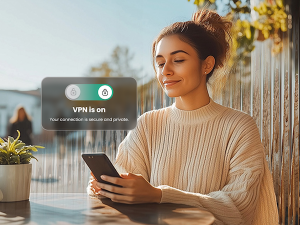
Tax season isn’t just busy for taxpayers—it’s prime time for scammers, too. As you gather your W-2s, 1099s, and other tax documents, cybercriminals are gearing up to exploit the flood of personal and financial data in circulation. From phishing emails posing as the IRS to fake tax preparers looking to steal your refund, these scams can lead to identity theft, fraudulent tax returns, and serious financial headaches.
The good news? IRS scams follow predictable patterns, and with a little awareness, you can spot the warning signs before falling victim. Let’s break down the most common tax scams and how you can safeguard your personal information this filing season.
A commonly used tactic involves hackers posing as collectors from the IRS, as tax preparers, or government bureaus. This tactic is pretty effective due to Americans’ concerns about misfiling their taxes or accidentally running into trouble with the IRS. Scammers take advantage of this fear, manipulating innocent users into providing sensitive information or money over the phone or by email. And in extreme cases, hackers may be able to infect computers with malware via malicious links or attachments sent through IRS email scams.
Another tactic used to take advantage of taxpayers is the canceled social security number scam. Hackers use robocalls claiming that law enforcement will suspend or cancel the victim’s Social Security number in response to taxes owed. Often, victims are scared into calling the fraudulent numbers back and persuaded into transferring assets to accounts that the scammer controls. Users need to remember that the IRS will only contact taxpayers through snail mail or in person, not over the phone.
Another scam criminals use involves emails impersonating the IRS. Victims receive a phishing email claiming to be from the IRS, reminding them to file their taxes or offering them information about their tax refund via malicious links. If a victim clicks on the link, they will be redirected to a spoofed site that collects the victim’s personal data, facilitating identity theft. What’s more, a victim’s computer can become infected with malware if they click on a link with malicious code, allowing fraudsters to steal more data.
Scammers also take advantage of the fact that many users seek out the help of a tax preparer or CPA during this time. These criminals will often pose as professionals, accepting money to complete a user’s taxes but won’t sign the return. This makes it look like the user completed the return themselves. However, these ghost tax preparers often lie on the return to make the user qualify for credits they haven’t earned or apply changes that will get them in trouble. Since the scammers don’t sign, the victim will then be responsible for any errors. This could lead to the user having to repay money owed, or potentially lead to an audit.
While these types of scams can occur at any time of the year, they are especially prevalent leading up to the April tax filing due date. Consumers need to be on their toes during tax season to protect their personal information and keep their finances secure. To avoid being spoofed by scammers and identity thieves, follow these tips:
File before cybercriminals do it for you. The easiest defense you can take against tax seasons schemes is to get your hands on your W-2 and file as soon as possible. The more prompt you are to file, the less likely your data will be raked in by a cybercriminal.
Keep an eye on your credit and your identity. Keeping tabs on your credit report and knowing if your personal information has been compromised in some way can help prevent tax fraud. Together, they can let you know if someone has stolen your identity or if you have personal info on the dark web that could lead to identity theft.
Beware of phishing attempts. It’s clear that phishing is the primary tactic crooks are leveraging this tax season, so it’s crucial you stay vigilant around your inbox. This means if any unfamiliar or remotely suspicious emails come through requesting tax data, double check their legitimacy with a manager or the security department before you respond. Remember: the IRS will not initiate contact with taxpayers by email, text messages, or social media channels to request personal or financial info. So someone contacts you that way, ignore the message.
Watch out for spoofed websites. Scammers have extremely sophisticated tools that help disguise phony web addresses for DIY tax software, such as stolen company logos and site designs. To avoid falling for this, go directly to the source. Type the address of a website directly into the address bar of your browser instead of following a link from an email or internet search. If you receive any suspicious links in your email, investigating the domain is usually a good way to tell if the source is legitimate or not.
Use a VPN, especially in public. Also known as a virtual private network, a VPN helps protect your vital personal info and other data with bank-grade encryption. The VPN encrypts your internet connection to keep your online activity private on any network, even public networks. Using a public network without a VPN can increase your risk because others on the network can potentially spy on your browsing and activity. If you’re new to the notion of using a VPN, check out this article on VPNs and how to choose one so that you can get the best protection and privacy possible. (Our McAfee+ plans offer a VPN as part of your subscription.)
Protect yourself from scam messages. Scammers also send links to scam sites via texts, social media messages, and email. Text Scam Detector can help you spot if the message you got is a fake. It uses AI technology that automatically detects links to scam URLs. If you accidentally click, don’t worry, it can block risky sites if you do.
Clean up your personal info online. Crooks and scammers have to find you before they can contact you. After all, they need to get your phone number or email from somewhere. Sometimes, that’s from “people finder” and online data brokers that gather and sell personal info to any buyer. Including crooks. McAfee Personal Data Cleanup can remove your personal info from the data broker sites scammers use to contact their victims.
Consider an identity theft protection solution. If for some reason your personal data does become compromised, be sure to use an identity theft solution such as McAfee Identity Theft Protection, which allows users to take a proactive approach to protect their identities with personal and financial monitoring and recovery tools to help keep their identities personal and secured.
The post Watch Out For IRS Scams and Avoid Identity Theft appeared first on McAfee Blog.

Before you take the fun-looking quiz that popped up in your social media feed, think twice. The person holding the answers may be a hacker.
Where people go, hackers are sure to follow. So it’s no surprise hackers have set up shop on social media. This has been the case for years, yet now social media-based crime is on the rise. Since 2021, total reported losses to this type of fraud reached $2.7 billion.
Among these losses are cases of identity theft, where criminals use social media to gather personal information and build profiles of potential victims they can target. Just as we discussed in our recent blog, “Can thieves steal identities with only a name and address?” these bits of information are important pieces in the larger jigsaw puzzle that is your overall identity.
Let’s uncover these scams these crooks use so that you can steer clear and stay safe.
“What’s your spooky Halloween name?” or “What’s your professional wrestler name?” You’ve probably seen a few of those and similar quizzes in your feed where you use the street you grew up on, your birthdate, your favorite song, and maybe the name of a beloved first pet to cook up a silly name or some other result. Of course, these are pieces of personal information, sometimes the answer to commonly used security questions by banks and other financial institutions. (Like, what was the model of your first car?) With this info in hand, a hacker could attempt to gain access to your accounts.
Similarly, scammers will also post surveys with the offer of a gift card to a popular retailer. All you have to do is fork over your personal info. Of course, there’s no gift card coming. Meanwhile, that scammer now has some choice pieces of personal info that they can potentially use against you.
How to avoid them: Simply put, don’t take those quizzes and surveys online.
The list here is long. These include posts and direct messages about phony relief funds, grants, and giveaways—along with bogus business opportunities that run the gamut from thinly veiled pyramid schemes and gifting circles to mystery shopper jobs. What they all have in common is that they’re run by scammers who want your information, money, or both. If this sounds familiar, like those old emails about transferring funds for a prince in some faraway nation, it is. Many of these scams simply made the jump from email to social media platforms.
How to avoid them: Research any offer, business opportunity, or organization that reaches out to you. A good trick is to do a search of the organization’s name plus the term “scam” or “review” or “complaint” to see if anything sketchy comes up.
If there’s one government official that scammers like to use to scare you, it’s the tax collector. These scammers will use social media messaging (and other mediums like emails, texts, and phone calls) to pose as an official who’s either demanding back taxes or offering a refund or credit—all of which are bogus and all of which involve you handing over your personal info, money, or both.
How to avoid them: Delete the message. In the U.S., the IRS and other government agencies will never reach out to you in this way or ask you for your personal information. Likewise, they won’t demand payment via wire transfer, gift cards, or cryptocurrency like Bitcoin. Only scammers will.
These are far more targeted than the scams listed above because they’re targeted and often rely upon specific information about you and your family. Thanks to social media, scammers can gain access to that info and use it against you. One example is the “grandkid scam” where a hacker impersonates a grandchild and asks a grandparent for money. Similarly, there are family emergency scams where a bad actor sends a message that a family member was in an accident or arrested and needs money quickly. In all, they rely on a phony story that often involves someone close to you who’s in need or trouble.
How to avoid them: Take a deep breath and confirm the situation. Reach out to the person in question or another friend or family member to see if there really is a concern. Don’t jump to pay right away.
This is one of the most targeted attacks of all—the con artist who strikes up an online relationship to bilk a victim out of money. Found everywhere from social media sites to dating apps to online forums, this scam involves creating a phony profile and a phony story to go with it. From there, the scammer will communicate several times a day, perhaps talking about their exotic job in some exotic location. They’ll build trust along the way and eventually ask the victim to wire money or purchase gift cards.
How to avoid them: Bottom line, if someone you’ve never met in person asks you for money online, it’s a good bet that it’s a scam. Don’t do it.
Now with an idea of what the bad actors are up to out there, here’s a quick rundown of things you can do to protect yourself further from the social media scams they’re trying to pull.
Above and beyond what we’ve covered so far, some online protection basics can keep you safer still. Comprehensive online protection software will help you create strong, unique passwords for all your accounts, help you keep from clicking links to malicious sites, and prevent you from downloading malware. Moreover, it can provide you with identity protection services like ours, which keep your personal info private with around-the-clock monitoring of your email addresses and bank accounts with up to $1M of ID theft insurance.
Together, with some good protection and a sharp eye, you can avoid those identity theft scams floating around on social media—and get back to enjoying time spent online with your true family and friends.
The post Quizzes and Other Identity Theft Schemes to Avoid on Social Media appeared first on McAfee Blog.

What’s the difference between identity fraud and identity theft? Well, it’s subtle, so much so that it’s easy to use them nearly interchangeably. While both can take a bite out of your wallet, they are different—and knowing the differences can help you understand what’s at stake.
Let’s start with an overview and a few examples of each.
So there’s that subtle difference we mentioned. Identity fraud involves the misuse of an existing account. Identity theft means the theft of your personal information, which is then used to impersonate you in some way, such as opening new accounts in your name.
Above and beyond those definitions and examples, a couple of real-life examples put the differences in perspective as well.
As for identity fraud, individual cases of fraud don’t always make the headlines, but that’s not to say you won’t hear about it in a couple of different ways.
The first way may be news stories about data breaches, where hackers gain things like names, emails, and payment information from companies or organizations. That info can then end up in the hands of a fraudster, who then accesses those accounts to drain funds or make purchases.
On a smaller scale, you may know someone who has had to get a new credit or debit card because theirs was compromised, perhaps by a breach or by mistakenly making a payment through an insecure website or by visiting a phony login page as part of a phishing attack. These can lead to fraud as well.
It usually starts with someone saying anything from, “That’s strange …” to “Oh, no!” There’ll be a strange charge on your credit card bill, a piece of mail from a bill collector, or a statement from an account you never opened—just to name a few things.
With that, I have a few recent blogs that help you spot all kinds of identity crime, along with advice to help keep it from happening to you in the first place:
While there are differences between identity fraud and identity theft, they do share a couple of things in common: you can take steps to prevent them, and you can take steps to limit their impact should you find yourself faced with one or the other.
The articles called out above will give you the details, yet staying safe begins with vigilance. Check on your accounts and credit reports regularly and really scrutinize what’s happening in them. Consider covering yourself with an identity monitoring solution — and act on anything that looks strange or outright fishy by reporting it to the company or institution in question.
The post How To Tell The Difference Between Identity Fraud and Identity Theft? appeared first on McAfee Blog.

When it comes to identity theft, trust your gut when something doesn’t feel right. Follow up. What you’re seeing could be a problem.
A missing bill or a mysterious charge on your credit card could be the tip of an identity theft iceberg, one that can run deep if left unaddressed. Here, we’ll look at several signs of identity theft that likely need some investigation and the steps you can take to take charge of the situation.
Unfortunately, it can happen in several ways.
In the physical world, it can happen simply because you lost your wallet or debit card. However, there are also cases where someone gets your information by going through your mail or trash for bills and statements. In other more extreme cases, theft can happen by someone successfully registering a change of address form in your name (although the U.S. Postal Service has security measures in place that make this difficult).
In the digital world, that’s where the avenues of identity theft blow wide open. It could come by way of a data breach, a thief “skimming” credit card information from a point-of-sale terminal, or by a dedicated crook piecing together various bits of personal information that have been gathered from social media, phishing attacks, or malware designed to harvest information. Additionally, thieves may eavesdrop on public Wi-Fi and steal information from people who are shopping or banking online without the security of a VPN.
Regardless of how crooks pull it off, identity theft is on the rise. According to the Federal Trade Commission (FTC), identity theft claims jumped up from roughly 650,000 claims in 2019 to 1 million in 2023. Of the reported fraud cases where a dollar loss was reported, the FTC calls out the following top three contact methods for identity theft:
However, phone calls, texts, and email remain the most preferred contact methods that fraudsters use, even if they are less successful in creating dollar losses than malicious websites, ads, and social media.
Identity thieves leave a trail. With your identity in hand, they can charge things to one or more of your existing accounts—and if they have enough information about you, they can even create entirely new accounts in your name. Either way, once an identity thief strikes, you’re probably going to notice that something is wrong. Possible signs include:
As you can see, the signs of possible identity theft can run anywhere from, “Well, that’s strange …” to “OH NO!” However, the good news is that there are several ways to check if someone is using your identity before it becomes a problem – or before it becomes a big problem that gets out of hand.
The point is that if you suspect fraud, you need to act right away. With identity theft becoming increasingly commonplace, many businesses, banks, and organizations have fraud reporting mechanisms in place that can assist you should you have any concerns. With that in mind, here are some immediate steps you can take:
Whether you spot a curious charge on your bank statement or you discover what looks like a fraudulent account when you get your free credit report, let the bank or business involved know you suspect fraud. With a visit to their website, you can track down the appropriate number to call and get the investigation process started.
Some businesses will require you to file a local police report to acquire a case number to complete your claim. Even beyond a business making such a request, filing a report is still a good idea. Identity theft is still theft and reporting it provides an official record of the incident. Should your case of identity theft lead to someone impersonating you or committing a crime in your name, filing a police report right away can help clear your name down the road. Be sure to save any evidence you have, like statements or documents that are associated with the theft. They can help clean up your record as well.
The FTC’s identity theft website is a fantastic resource should you find yourself in need. Above and beyond simply reporting the theft, the FTC can provide you with a step-by-step recovery plan—and even walk you through the process if you create an account with them. Additionally, reporting theft to the FTC can prove helpful if debtors come knocking to collect on any bogus charges in your name. You can provide them with a copy of your FTC report and ask them to stop.
You can place a free one-year fraud alert with one of the major credit bureaus (Experian, TransUnion, Equifax), and they will notify the other two. A fraud alert will make it tougher for thieves to open accounts in your name, as it requires businesses to verify your identity before issuing new credit in your name.
A credit freeze goes a step further. As the name implies, a freeze prohibits creditors from pulling your credit report, which is needed to approve credit. Such a freeze is in place until you lift it, and it will also apply to legitimate queries as well. Thus, if you intend to get a loan or new credit card while a freeze is in place, you’ll likely need to take extra measures to see that through. Contact each of the major credit bureaus (Experian, TransUnion, Equifax) to put a freeze in place or lift it when you’re ready.
This can run the gamut from closing any false accounts that were set up in your name, removing bogus charges, and correcting information in your credit report such as phony addresses or contact information. With your FTC report, you can dispute these discrepancies and have the business correct the record. Be sure to ask for written confirmation and keep a record of all documents and conversations involved.
If you receive a notice from the IRS that someone used your identity to file a tax return in your name, follow the information provided by the IRS in the notice. From there, you can file an identity theft affidavit with the IRS. If the notice mentions that you were paid by an employer you don’t know, contact that employer as well and let them know of possible fraud—namely that someone has stolen your identity and that you don’t truly work for them.
Also, be aware that the IRS has specific guidelines as to how and when they will contact you. As a rule, they will most likely contact you via physical mail delivered by the U.S. Postal Service. (They won’t call or apply harassing pressure tactics—only scammers do that.) Identity-based tax scams are a topic all of their own, and for more on it, you can check out this article on tax scams and how to avoid them.
Another downside of identity theft is that it can mark the start of a long, drawn-out affair. One instance of theft can possibly lead to another, so even what may appear to be an isolated bad charge on your credit card calls for keeping an eye on your identity. Many of the tools you would use up to this point still apply, such as checking up on your credit reports, maintaining fraud alerts as needed, and reviewing your accounts closely.
With all the time we spend online as we bank, shop, and simply surf, we create and share all kinds of personal information—information that can get collected and even stolen. The good news is that you can prevent theft and fraud with online protection software, such as McAfee+ Ultimate.
With McAfee+ Ultimate you can:
In all, it’s our most comprehensive privacy, identity, and device protection plan, built for a time when we rely so heavily on the internet to go about our day, whether that’s work, play, or simply getting things done.
Realizing that you’ve become a victim of identity theft carries plenty of emotion with it, which is understandable—the thief has stolen a part of you to get at your money, information, and even reputation. Once that initial rush of anger and surprise has passed, it’s time to get clinical and get busy. Think like a detective who’s building – and closing – a case. That’s exactly what you’re doing. Follow the steps, document each one, and build up your case file as you need. Staying cool, organized, and ready with an answer to any questions you’ll face in the process of restoring your identity will help you see things through.
Once again, this is a good reminder that vigilance is the best defense against identity theft from happening in the first place. While there’s no absolute, sure-fire protection against it, there are several things you can do to lower the odds in your favor. And at the top of the list is keeping consistent tabs on what’s happening across your credit reports and accounts.
The post How to Detect Signs of Identity Theft appeared first on McAfee Blog.

Can thieves steal identities with only a name and address?
In short, the answer is “no.” Which is a good thing, as your name and address are in fact part of the public record. Anyone can get a hold of them. However, because they are public information, they are still tools that identity thieves can use.
If you think of your identity as a jigsaw puzzle, your name and address are the first two pieces that they can use to build a bigger picture and ultimately put your identity at risk.
With that, let’s look at some other key pieces of your identity that are associated with your name and address—and what you can do to protect them.
For starters, this information is so general that it is of little value in and of itself to an identity thief. Yet a determined identity thief can do a bit of legwork and take a few extra steps to use them as a springboard for other scams.
For example, with your name and address a thief could:
There are volumes of public information that are readily available should someone want to add some more pieces to your identity jigsaw puzzle, such as:
In the U.S., the availability of such information will vary from state to state and different levels of government may have different regulations about what information gets filed—in addition to whether and how those reports are made public. Globally, different nations and regions will collect varying amounts of public information and have their own regulations in place as well. More broadly, though, many of these public databases are now online. Consequently, accessing them is easier than the days when getting a hold of that information required an in-person visit to a library or public office.
Cybercriminals can gain additional information about you from other online sources, such as data brokers. And data brokerage is a big business, a global economy estimated at $280 billion U.S. dollars a year. What fuels it? Personal information, representing thousands of data points on billions of people scraped from public records, social media, smartphone apps, shopper loyalty cards, third-party sources, and sometimes other data broker sites as well.
The above-the-board legal intent of data broker sites is to sell that information to advertisers so that they can create highly targeted campaigns based on people’s behaviors, travels, interests, and even political leanings. Others such as law enforcement officials, journalists, and others who are conducting background checks will use them too.
On the dark side, hackers, scammers, and thieves will buy this information as well, which they can use to commit identity theft and fraud. The thing is, data brokers will sell to anyone. They don’t discriminate.
Phishing attacks aren’t just for email, texts, and direct messages. In fact, thieves are turning to old tricks via old-fashioned physical mail. That includes sending phony offers or impersonating officials of government institutions, all designed to trick you into giving up your personally identifiable information (PII).
What might that look like in your mailbox? They can take the form of bogus lottery prizes that request bank information for routing (non-existent) winnings. Another favorite of scammers is bogus tax notifications that demand immediate payment. In all, many can look quite convincing at first blush, yet there are ready ways you can spot them. In fact, many of the tips for avoiding these physical mail phishing attacks are the same for avoiding phishing attacks online.
Recently, I’ve seen a few news stories like this where thieves reportedly abuse the change-of-address system with the U.S. Postal Service. Thieves will simply forward your mail to an address of their choosing, which can drop sensitive information like bank and credit card statements in their mailbox. From there, they could potentially have new checks sent to them or perhaps an additional credit card—both of which they can use to drain your accounts and run up your bills.
The Postal Service has mechanisms in place to prevent this, however. Among these, the Postal Service will send you a physical piece of mail to confirm the forwarding. So, if you ever receive mail from the Postal Service, open it and give it a close look. If you get such a notice and didn’t order the forwarding, visit your local post office to get things straightened out. Likewise, if it seems like you’re missing bills in the mail, that’s another good reason to follow up with your post office and the business in question to see if there have been any changes made in your mail forwarding.
So while your name and address are out there for practically all to see, they’re largely of little value to an identity thief on their own. But as mentioned above, they are key puzzle pieces to your overall identity. With enough of those other pieces in hand, that’s where an identity thief can cause trouble.
Other crucial pieces of your identity include:
Let’s start with the biggest one. This is the master key to your identity, as it is one of the most unique identifiers you have. As I covered in my earlier blog on Social Security fraud, a thief can unlock everything from credit history and credit line to tax refunds and medical care with your Social Security or tax ID number. In extreme cases, they can use it to impersonate you for employment, healthcare, and even in the event of an arrest.
You can protect your Social Security Number by keeping it locked in a safe place (rather than in your wallet) and by providing your number only when absolutely necessary. For more tips on keeping your number safe, drop by that blog on Social Security fraud I mentioned.
Thieves have figured out ways of getting around the fact that IDs like these include a photo. They may be able to modify or emulate these documents “well enough” to pull off certain types of fraud, particularly if the people requesting their bogus documents don’t review them with a critical eye.
Protecting yourself in this case means knowing where these documents are at any time. (With passports, you may want to store those securely like your Social Security or tax ID number.) Also be careful when you share this information, as the identifiers on these documents are highly unique. If you’re uncomfortable with sharing this information, you can ask if other forms of ID might work—or if this information is really needed at all. Also, take a moment to make copies of these documents and store them in a secure place. This can help you provide important info to the proper authorities if they’re lost or stolen.
With data breaches large and small making the news (and many more that do not), keeping a sharp eye on your accounts is a major part of identity theft prevention. We talk about this topic quite often, and it’s worth another mention because protecting these means protecting yourself from thieves who are after direct access to your finances and more.
Secure your digital accounts for banking, credit cards, financials, and shopping by using strong, unique passwords for each of your accounts that you change every 60 days. Sound like a lot of work? Let a password manager do it for you, which you can find in comprehensive online protection software. By changing your strong passwords and keeping them unique can help prevent you from becoming a victim if your account information is part of a breach—by the time a crook attempts to use it, you may have changed it and made it out of date.
In addition to protecting the core forms of identity mentioned above, a few other good habits go a long way toward keeping your identity secure.
By protecting your devices, you protect what’s on them, like your personal information. Comprehensive online protection software can protect your identity in several ways, like creating and managing the strong, unique passwords we talked about and providing further services that monitor and protect your identity—in addition to digital shredders that can permanently remove sensitive documents (simply deleting them won’t do that alone.) Further, it can monitor your identity and monitor your credit, further protecting you from theft and fraud.
Identity theft where thieves dig through trash or go “dumpster diving” for literal scraps of personal info in bills and statements, has been an issue for some time. You can prevent it by shredding up any paper medical bills, tax documents, and checks once you’re through with them. Paper shredders are inexpensive, and let’s face it, kind of fun too. Also, if you’re traveling, have a trusted someone collect your mail or have the post office put a temporary hold on your mail. Thieves still poach mail from mailboxes too.
Getting statements online cuts the paper out of the equation and thus removes another thing that a thief can physically steal and possibly use against you. Whether you use electronic statements through your bank, credit card company, medical provider, or insurance company, use a secure password and a secure connection provided by a VPN. Both will make theft of your personal info far tougher on identity thieves.
A VPN is a Virtual Private Network, a service that protects your data and privacy online. It creates an encrypted tunnel to keep you more anonymous online by masking your IP address, device information, and the data you’re passing along that connection. In this way, it makes it far more difficult for advertisers, data brokers, and bad actors to skim your private information—in addition to shielding your information from crooks and snoops while you’re banking, shopping, or handling any kind of sensitive information online.
Give your statements a close look each time they come around. While many companies and institutions have fraud detection mechanisms in place, they don’t always catch every instance of fraud. Look out for strange purchases or charges and follow up with your bank or credit card company if you suspect fraud. Even the smallest charge could be a sign that something shady is afoot.
This is a powerful tool for spotting identity theft. And in many cases, it’s free to do so. In the U.S., the Fair Credit Reporting Act (FCRA) requires the major credit agencies to provide you with a free credit check at least once every 12 months. Canada provides this service, and the UK has options to receive free reports as well, along with several other nations. It’s a great idea to check your credit report, even if you don’t suspect a problem.
If the thought of your personal info being bought and sold puts you off, there’s something you can do about it. Our Personal Data Cleanup service can scan some of the riskiest data broker sites and show you which ones are selling your personal info. It also provides guidance on how you can remove your data from those sites, and with select products, it can even manage the removal for you.
While thieves need more than just your name and address to commit the overwhelming majority of fraud, your name and address are centerpieces of the larger jigsaw puzzle that is your overall identity.
And the interesting thing is your puzzle gets larger and larger as time goes on. With each new account you create and service that you sign into, that’s one more piece added to the puzzle. Thieves love getting their hands on any pieces they can because with enough of them in place, they can try and pull a fast one in your name. By looking after each piece and knowing what your larger jigsaw puzzle looks like, you can help keep identity thieves out of your business and your life.
The post Can Thieves Steal Identities With Only a Name and Address? appeared first on McAfee Blog.

Did you just get word that your personal information may have been caught up in a data breach? If so, you can take steps to protect yourself from harm should your info get into the hands of a scammer or thief.
How does that information get collected in the first place? We share personal information with companies for multiple reasons simply by going about our day—to pay for takeout at our favorite restaurant, to check into a hotel, or to collect rewards at the local coffee shop. Of course, we use our credit and debit cards too, sometimes as part of an online account that tracks our purchase history.
In other words, we leave trails of data practically wherever we go these days, and that data is of high value to hackers. Thus, all those breaches we read about.
Whether it’s a major breach that exposes millions of records or one of many other smaller-scale breaches like the thousands that have struck healthcare providers, each one serves as a reminder that data breaches happen regularly and that we could find ourselves affected. Depending on the breach and the kind of information you’ve shared with the business or organization in question, information stolen in a breach could include:
What do crooks do with that data? Several things. Apart from using it themselves, they may sell that data to other criminals. Either way, this can lead to illicit use of credit and debit cards, draining of bank accounts, claiming tax refunds or medical expenses in the names of the victims, or, in extreme cases, assuming the identity of others altogether.
In all, data is a kind of currency in of itself because it has the potential to unlock several aspects of victim’s life, each with its own monetary value. It’s no wonder that big breaches like these have made the news over the years, with some of the notables including:
As mentioned, these are big breaches with big companies that we likely more than recognize. Yet smaller and mid-sized businesses are targets as well, with some 43% of data breaches involving companies of that size. Likewise, restaurants and retailers have seen their Point-of-Sale (POS) terminals compromised, right on down to neighborhood restaurants.
When a company experiences a data breach, customers need to realize that this could impact their online safety. If your favorite coffee shop’s customer database gets leaked, there’s a chance that your personal or financial information was exposed. However, this doesn’t mean that your online safety is doomed. If you think you were affected by a breach, you can take several steps to protect yourself from the potential side effects.
One of the most effective ways to determine whether someone is fraudulently using one or more of your accounts is to check your statements. If you see any charges that you did not make, report them to your bank or credit card company immediately. They have processes in place to handle fraud. While you’re with them, see if they offer alerts for strange purchases, transactions, or withdrawals.
Our credit monitoring service can help you keep an eye on this. It monitors changes to your credit score, report, and accounts with timely notifications and guidance so you can take action to tackle identity theft.
Breached and stolen information often ends up in dark web marketplaces where hackers, scammers, and thieves purchase it to commit yet more crime. Once it was difficult to know if your information was caught up in such marketplaces, yet now an identity monitoring service can do the detective work for you.
Our service monitors the dark web for your personal info, including email, government IDs, credit card and bank account info, and more. This can help keep your personal info safe with early alerts that show you if your data is found on the dark web, an average of 10 months ahead of similar services. From there, you’ll get guidance that you can act on, which can help protect your info and accounts from theft.
If you suspect that your data might have been compromised, place a fraud alert on your credit. This not only ensures that any new or recent requests undergo scrutiny, but also allows you to have extra copies of your credit report so you can check for suspicious activity. You can place one fraud alert with any of the three major credit reporting agencies (Equifax, Experian, TransUnion) and they will notify the other two. A fraud alert typically lasts for a year, although there are options for extending it as well.
Freezing your credit will make it highly difficult for criminals to take out loans or open new accounts in your name, as a freeze halts all requests to pull your credit—even legitimate ones. In this way, it’s a far stronger measure than placing a fraud alert. Note that if you plan to take out a loan, open a new credit card, or other activity that will prompt a credit report, you’ll need to take extra steps to see that through while the freeze is in place. (The organization you’re working with can assist with the specifics.) Unlike the fraud alert, you’ll need to contact each major credit reporting agency to put one in place. Also, a freeze lasts as long as you have it in place. You’ll have to remove it yourself, again with each agency.
You can centrally manage this process with our security freeze service, which stops companies from looking at your credit profile, and thus halts the application process for loans, credit cards, utilities, new bank accounts, and more. A security freeze won’t affect your credit score.
Ensure that your passwords are strong and unique. Many people utilize the same password or variations of it across all their accounts. Therefore, be sure to diversify your passcodes to ensure hackers cannot obtain access to all your accounts at once, should one password be compromised. You can also employ a password manager to keep track of your credentials, such as the one you’ll find in comprehensive online protection software.
If the unfortunate happens to you, an identity theft coverage & restoration service can help you get back on your feet. Ours offers $1 million in coverage for lawyer fees, travel expenses, and stolen funds reimbursement. It further provides support from a licensed recovery expert who can take the needed steps to repair your identity and credit. In all, it helps you recover the costs of identity theft along with the time and money it takes to recover from it.
You can take this step any time, even if you haven’t been caught up in a data breach. The fact is that data broker companies collect and sell thousands of pieces of information on millions and millions of people worldwide, part of a global economy estimated at $200 billion U.S. dollars a year. And they’ll sell it to anyone—from advertisers for their campaigns, to scammers who will use it for spammy emails, texts, and calls, and to thieves who use that information for identity theft.
Yet you can clean it up. Our personal data cleanup service can scan some of the riskiest data broker sites and show you which ones are selling your personal info. It also provides guidance on how you can remove your data from those sites and, with select products, even manage the removal for you.
Comprehensive online protection software will offer you the tools and services listed above, along with further features that can protect you online. That includes a VPN to keep your time online more private from online data collection while protecting it from thieves who’re out to steal credit card and account information. It also includes web browsing protection that can warn you of sketchy websites and malicious downloads that look to steal your information. In all, it’s thorough protection for your devices, privacy, and identity. And in a time of data breaches, that kind of protection has become essential.
The post How to Protect Yourself From Identity Theft After a Data Breach appeared first on McAfee Blog.